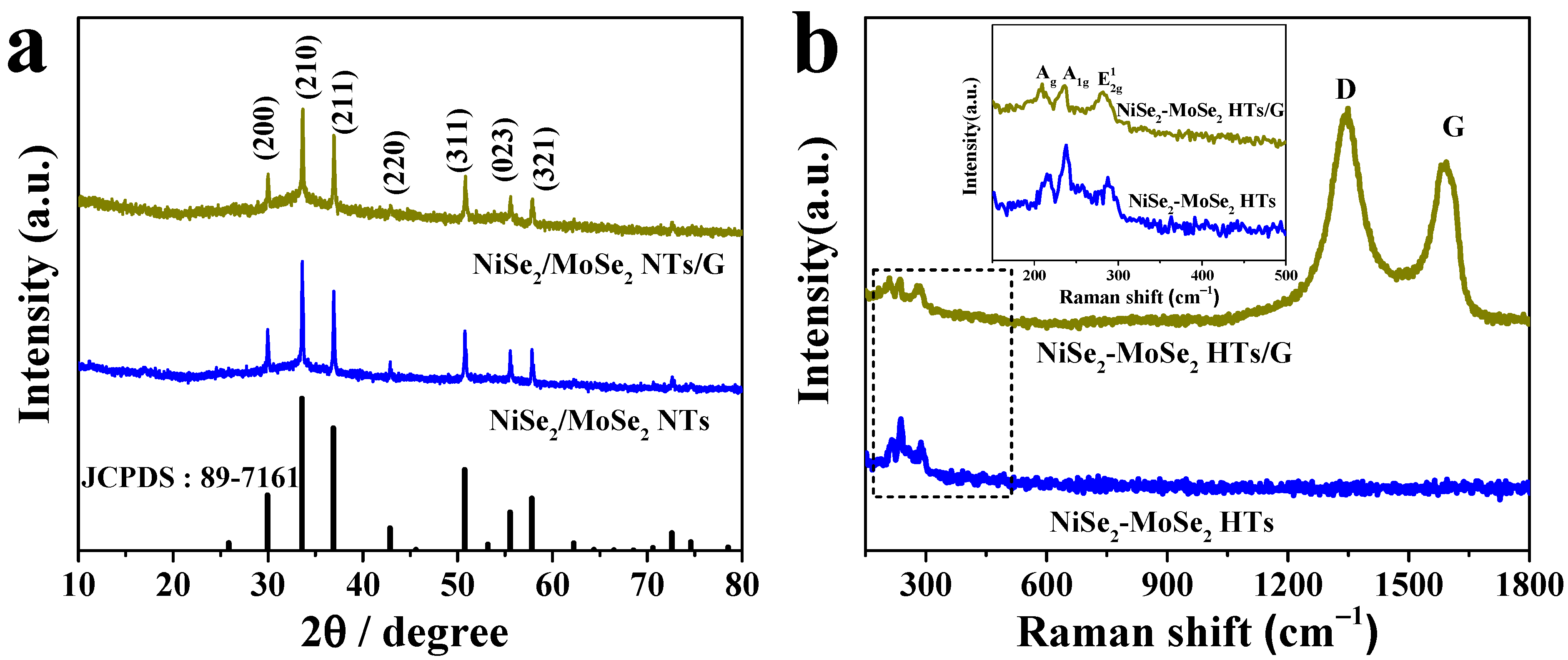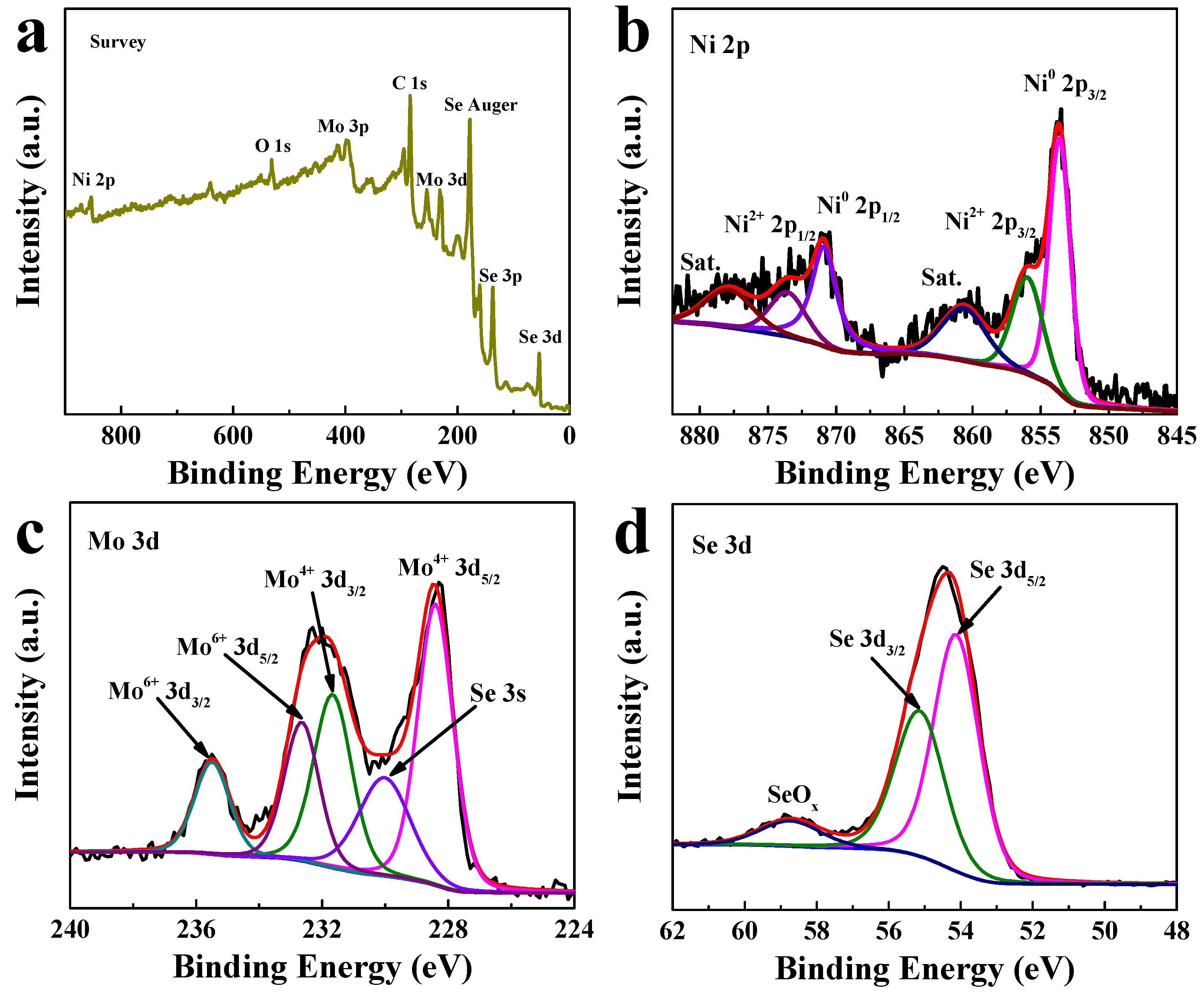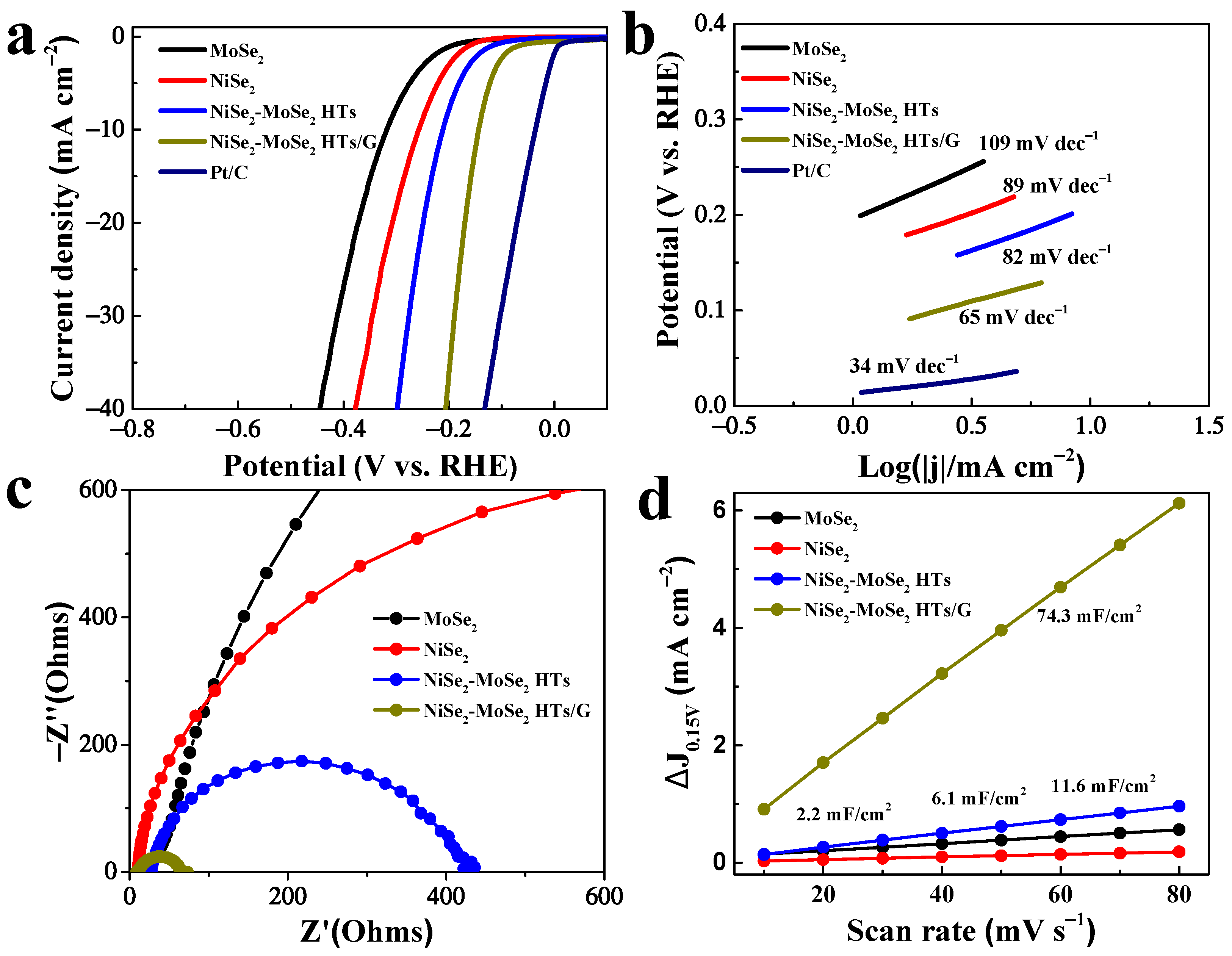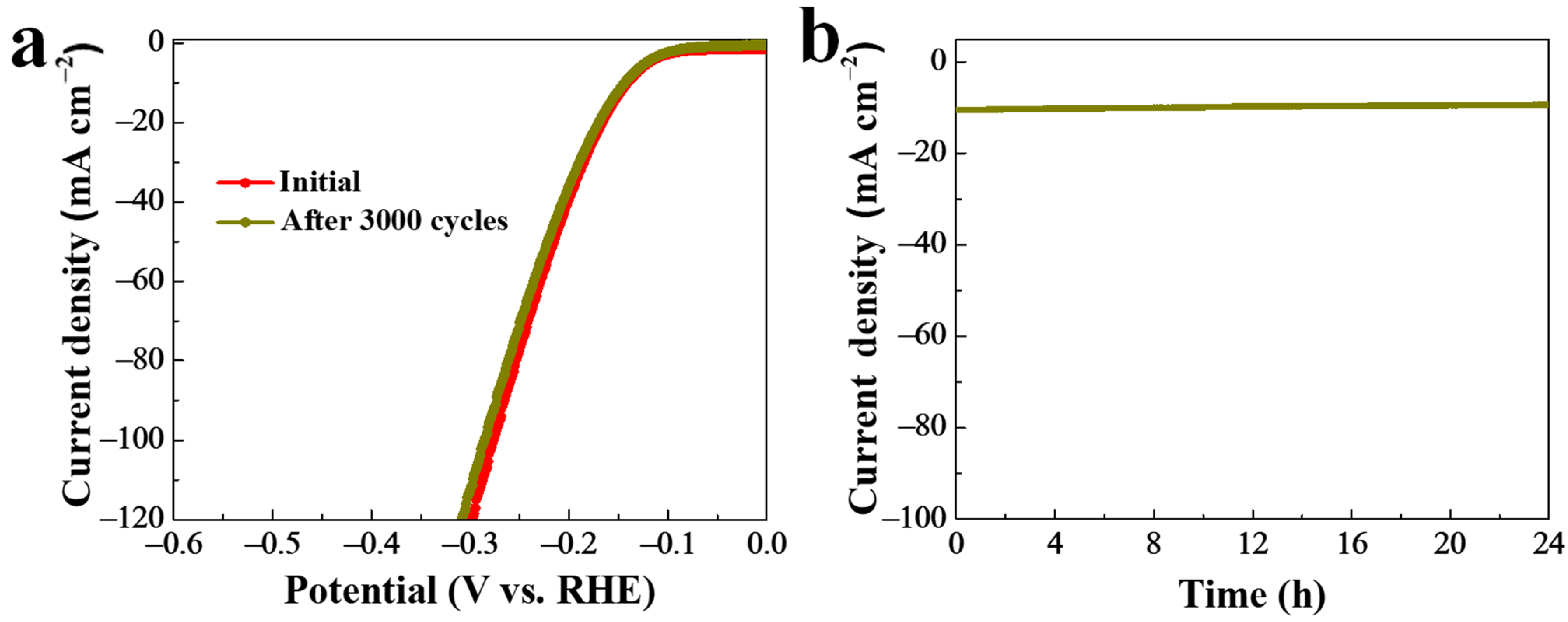In Situ Growth of NiSe2-MoSe2 Heterostructures on Graphene Nanosheets as High-Performance Electrocatalyst for Hydrogen Evolution Reaction
Abstract
:1. Introduction
2. Results and Discussion
3. Experimental Section
3.1. Synthesis of NiSe2-MoSe2 HTs/G
3.2. Synthesis of NiSe2/MoSe2 HTs
3.3. Synthesis of NiSe2 or MoSe2
3.4. Characterizations
3.5. Electrochemical Measurements
4. Conclusions
Supplementary Materials
Author Contributions
Funding
Data Availability Statement
Conflicts of Interest
References
- Seh, Z.W.; Kibsgaard, J.; Dickens, C.F.; Chorkendorff, I.; Nørskov, J.K.; Jaramillo, T.F. Combining theory and experiment in electrocatalysis: Insights into materials design. Science 2017, 355, eaad4998. [Google Scholar] [CrossRef] [PubMed] [Green Version]
- Men, Y.; Tan, Y.; Li, P.; Cao, X.; Jia, S.; Wang, J.; Chen, S.; Luo, W. Tailoring the 3d-orbital electron filling degree of metal center to boost alkaline hydrogen evolution electrocatalysis. Appl. Catal. B Environ. 2021, 284, 119718. [Google Scholar] [CrossRef]
- Yang, L.; Huang, L.; Yao, Y.; Jiao, L. In-situ construction of lattice-matching NiP2/NiSe2 heterointerfaces with electron redistribution for boosting overall water splitting. Appl. Catal. B Environ. 2021, 282, 119584. [Google Scholar] [CrossRef]
- Mao, B.; Sun, P.; Jiang, Y.; Meng, T.; Guo, D.; Qin, J.; Cao, M. Identifying the Transfer Kinetics of Adsorbed Hydroxyl as a Descriptor of Alkaline Hydrogen Evolution Reaction. Angew. Chem. Int. Ed. 2020, 59, 15232–15237. [Google Scholar] [CrossRef]
- Suen, N.; Hung, S.; Quan, Q.; Zhang, N.; Xu, Y.; Chen, H.M. Electrocatalysis for the oxygen evolution reaction: Recent development and future perspectives. Chem. Soc. Rev. 2017, 46, 337–365. [Google Scholar] [CrossRef]
- Zhang, H.; Maijenburg, A.W.; Li, X.; Schweizer, S.L.; Wehrspohn, R.B. Bifunctional Heterostructured Transition Metal Phosphides for Efficient Electrochemical Water Splitting. Adv. Funct. Mater. 2020, 30, 2003261. [Google Scholar] [CrossRef]
- Xie, C.; Chen, W.; Du, S.; Yan, D.; Zhang, Y.; Chen, J.; Liu, B.; Wang, S. In-situ phase transition of WO3 boosting electron and hydrogen transfer for enhancing hydrogen evolution on Pt. Nano Energy 2020, 71, 104653. [Google Scholar] [CrossRef]
- Zhang, Y.; Ouyang, B.; Xu, J.; Chen, S.; Rawat, R.S.; Fan, H.J. 3D Porous Hierarchical Nickel-Molybdenum Nitrides Synthesized by RF Plasma as Highly Active and Stable Hydrogen-Evolution-Reaction Electrocatalysts. Adv. Energy Mater. 2016, 6, 1600221. [Google Scholar] [CrossRef]
- Kibsgaard, J.; Chen, Z.; Reinecke, B.N.; Jaramillo, T. Engineering the surface structure of MoS2 to preferentially expose active edge sites for electrocatalysis. Nat. Mater. 2012, 11, 963–969. [Google Scholar] [CrossRef]
- Wang, H.; Xu, Z.; Zhang, Z.; Hu, S.; Ma, M.; Zhang, Z.; Zhou, W.; Liu, H. Addressable surface engineering for N-doped WS2 nanosheet arrays with abundant active sites and the optimal local electronic structure for enhanced hydrogen evolution reaction. Nanoscale 2020, 12, 22541–22550. [Google Scholar] [CrossRef]
- Wang, H.; Kong, D.; Johanes, P.; Cha, J.J.; Zheng, G.; Yan, K.; Liu, N.; Cui, Y. MoSe2 and WSe2 Nanofilms with Vertically Aligned Molecular Layers on Curved and Rough Surfaces. Nano Lett. 2013, 13, 3426–3433. [Google Scholar] [CrossRef] [PubMed]
- Kwon, I.S.; Kwak, I.H.; Debela, T.T.; Abbas, H.G.; Park, Y.C.; Ahn, J.-P.; Park, J.; Kang, H.S. Se-Rich MoSe2 Nanosheets and Their Superior Electrocatalytic Performance for Hydrogen Evolution Reaction. ACS Nano 2020, 14, 6295–6304. [Google Scholar] [CrossRef] [PubMed]
- Lin, L.; Sherrell, P.; Liu, Y.; Lei, W.; Zhang, S.; Zhang, H.; Wallace, G.G.; Chen, J. Engineered 2D Transition Metal Dichalcogenides-A Vision of Viable Hydrogen Evolution Reaction Catalysis. Adv. Energy Mater. 2020, 10, 1903870. [Google Scholar] [CrossRef]
- Zhang, X.; Lai, Z.; Ma, Q.; Zhang, H. Novel structured transition metal dichalcogenide nanosheets. Chem. Soc. Rev. 2018, 47, 3301–3338. [Google Scholar] [CrossRef]
- Kwon, I.S.; Kwak, I.H.; Ju, S.; Kang, S.; Han, S.; Park, Y.C.; Park, J.; Park, J. Adatom Doping of Transition Metals in ReSe2 Nanosheets for Enhanced Electrocatalytic Hydrogen Evolution Reaction. ACS Nano 2020, 14, 12184–12194. [Google Scholar] [CrossRef]
- Zhang, L.; Wang, T.; Sun, L.; Sun, Y.; Hu, T.; Xu, K.; Ma, F. Hydrothermal synthesis of 3D hierarchical MoSe2/NiSe2 composite nanowires on carbon fiber paper and their enhanced electrocatalytic activity for the hydrogen evolution reaction. J. Mater. Chem. A 2017, 5, 19752–19759. [Google Scholar] [CrossRef]
- Najafi, L.; Bellani, S.; Oropesa-Nuñez, R.; Prato, M.; Martín-García, B.; Brescia, R.; Bonaccorso, F. Carbon Nanotube-Supported MoSe2 Holey Flake:Mo2C Ball Hybrids for Bifunctional pH-Universal Water Splitting. ACS Nano 2019, 13, 3162–3176. [Google Scholar] [CrossRef]
- Tan, C.; Luo, Z.; Chaturvedi, A.; Cai, Y.; Du, Y.; Gong, Y.; Huang, Y.; Lai, Z.; Zhang, X.; Zheng, L.; et al. Preparation of High-Percentage 1T-Phase Transition Metal Dichalcogenide Nanodots for Electrochemical Hydrogen Evolution. Adv. Mater. 2018, 30, 1705509. [Google Scholar] [CrossRef]
- Jian, C.; Hong, W.; Cai, Q.; Liu, W. The local electronic structure modulation of the molybdenum selenide–nitride heterojunction for efficient hydrogen evolution reaction. J. Mater. Chem. A 2021, 9, 26113–26118. [Google Scholar] [CrossRef]
- Zhao, G.; Li, P.; Rui, K.; Chen, Y.; Dou, S.X.; Sun, W. CoSe2/MoSe2 Heterostructures with Enriched Water Adsorption/Dissociation Sites towards Enhanced Alkaline Hydrogen Evolution Reaction. Chem. Eur. J. 2018, 24, 11158–11165. [Google Scholar] [CrossRef] [Green Version]
- Wang, C.; Zhang, P.; Lei, J.; Dong, W.; Wang, J. Integrated 3D MoSe2@Ni0.85Se Nanowire Network with Synergistic Cooperation as Highly Efficient Electrocatalysts for Hydrogen Evolution Reaction in Alkaline Medium. Electrochim. Acta 2017, 246, 712–719. [Google Scholar] [CrossRef]
- Zhou, X.; Liu, Y.; Ju, H.; Pan, B.; Zhu, J.; Ding, T.; Wang, C.; Yang, Q. Design and Epitaxial Growth of MoSe2–NiSe Vertical Heteronanostructures with Electronic Modulation for Enhanced Hydrogen Evolution Reaction. Chem. Mater. 2016, 28, 1838–1846. [Google Scholar] [CrossRef]
- Qin, R.; Wang, P.; Li, Z.; Zhu, J.; Cao, F.; Xu, H.; Ma, Q.; Zhang, J.; Yu, J.; Mu, S. Ru-Incorporated Nickel Diselenide Nanosheet Arrays with Accelerated Adsorption Kinetics toward Overall Water Splitting. Small 2022, 18, 2105305. [Google Scholar] [CrossRef] [PubMed]
- Wang, X.; Zheng, B.; Yu, B.; Wang, B.; Hou, W.; Zhang, W.; Chen, Y. In situ synthesis of hierarchical MoSe2-CoSe2 nanotubes as an efficient electrocatalyst for the hydrogen evolution reaction in both acidic and alkaline media. J. Mater. Chem. A 2018, 6, 7842–7850. [Google Scholar] [CrossRef]
- Lu, H.; Zhang, Y.; Huang, Y.; Zhang, C.; Liu, T. Reaction Packaging CoSe2 Nanoparticles in N-Doped Carbon Polyhedra with Bifunctionality for Overall Water Splitting. ACS Appl. Mater. Interfaces 2018, 11, 3372–3381. [Google Scholar] [CrossRef]
- Zhang, M.; Hu, A.; Liu, Z.; Xu, Y.; Fan, B.; Tang, Q.; Zhang, S.; Deng, W.; Chen, X. Synergistic effect of three-dimensional cobalt diselenide/carbon nanotube arrays composites for enhanced hydrogen evolution reaction. Electrochim. Acta 2018, 285, 254–261. [Google Scholar] [CrossRef]
- Mao, S.; Wen, Z.; Ci, S.; Guo, X.; Ostrikov, K.K.; Chen, J. Perpendicularly Oriented MoSe2/Graphene Nanosheets as Advanced Electrocatalysts for Hydrogen Evolution. Small 2015, 11, 414–419. [Google Scholar] [CrossRef]
- Chia, X.; Pumera, M. Characteristics and performance of two-dimensional materials for electrocatalysis. Nat. Catal. 2018, 1, 909–921. [Google Scholar] [CrossRef]
- Yi, Y.; Sun, Z.; Li, C.; Tian, Z.; Lu, C.; Shao, Y.; Li, J.; Sun, J.; Liu, Z. Designing 3D Biomorphic Nitrogen-Doped MoSe2/Graphene Composites toward High-Performance Potassium-Ion Capacitors. Adv. Funct. Mater. 2019, 30, 1903878. [Google Scholar] [CrossRef]
- Wang, X.; He, J.; Yu, B.; Sun, B.; Yang, D.; Zhang, X.; Zhang, Q.; Zhang, W.; Gu, L.; Chen, Y. CoSe2 nanoparticles embedded MOF-derived Co-N-C nanoflake arrays as efficient and stable electrocatalyst for hydrogen evolution reaction. Appl. Catal. B Environ. 2019, 258, 117996. [Google Scholar] [CrossRef]
- Yang, Y.; Zhang, W.; Xiao, Y.; Shi, Z.; Cao, X.; Tang, Y.; Gao, Q. CoNiSe2 heteronanorods decorated with lay-ered-double-hydroxides for efficient hydrogen evolution. Appl. Catal. B Environ. 2019, 242, 132–139. [Google Scholar] [CrossRef]
- Hao, T.; Liu, Y.; Liu, G.; Peng, C.; Chen, B.; Feng, Y.; Ru, J.; Yang, J. Insight into faradaic mechanism of polyaniline@NiSe2 core-shell nanotubes in high-performance supercapacitors. Energy Storage Mater. 2019, 23, 225–232. [Google Scholar] [CrossRef]
- Liu, C.; Wang, K.; Zheng, X.; Liu, X.; Liang, Q.; Chen, Z. Rational design of MoSe2-NiSe@carbon heteronanostructures for efficient electrocatalytic hydrogen evolution in both acidic and alkaline media. Carbon 2018, 139, 1–9. [Google Scholar] [CrossRef]
- Zhang, X.; Zhang, Y.; Zhang, Y.; Jiang, W.; Zhang, Q.; Yang, Y.; Gu, L.; Hu, J.; Wan, L. Phase-Controlled Synthesis of 1T-MoSe2/NiSe Heterostructure Nanowire Arrays via Electronic Injection for Synergistically Enhanced Hydrogen Evolution. Small Methods 2019, 3, 1800317. [Google Scholar] [CrossRef]
- Wang, G.; Chen, W.; Chen, G.; Huang, J.; Song, C.; Chen, D.; Du, Y.; Li, C.; Ostrikov, K.K. Trimetallic Mo–Ni–Co selenides nanorod electrocatalysts for highly-efficient and ultra-stable hydrogen evolution. Nano Energy 2020, 71, 104637. [Google Scholar] [CrossRef]
- Zhang, Y.; Yang, J.; Dong, Q.; Geng, H.; Zheng, Y.; Liu, Y.; Wang, W.; Li, C.C.; Dong, X. Highly Dispersive MoP Nanoparticles Anchored on Reduced Graphene Oxide Nanosheets for an Efficient Hydrogen Evolution Reaction Electrocatalyst. ACS Appl. Mater. Interfaces 2018, 10, 26258–26263. [Google Scholar] [CrossRef]
- Wang, X.; Chen, Y.; Zheng, B.; Qi, F.; He, J.; Li, P.; Zhang, W. Few-layered WSe2 nanoflowers anchored on graphene nanosheets: A highly efficient and stable electrocatalyst for hydrogen evolution. Electrochim. Acta 2016, 222, 1293–1299. [Google Scholar] [CrossRef]
- Zhang, L.; Sun, L.; Huang, Y.; Sun, Y.; Hu, T.; Xu, K.; Ma, F. Hydrothermal synthesis of N-doped RGO/MoSe2 composites and enhanced electro-catalytic hydrogen evolution. J. Mater. Sci. 2017, 52, 13561–13571. [Google Scholar] [CrossRef]
- Kuang, P.; Tong, T.; Fan, K.; Yu, J. In Situ Fabrication of Ni-Mo Bimetal Sulfide Hybrid as an Efficient Electrocatalyst for Hy-drogen Evolution over a Wide pH Range. ACS Catal. 2017, 7, 6179–6187. [Google Scholar] [CrossRef]
- Wu, M.; Huang, Y.; Cheng, X.; Geng, X.; Tang, Q.; You, Y.; Yu, Y.; Zhou, R.; Xu, J. Arrays of ZnSe/MoSe2 Nanotubes with Electronic Modulation as Efficient Electrocatalysts for Hydrogen Evolution Reaction. Adv. Mater. Interfaces 2017, 4, 1700948. [Google Scholar] [CrossRef]
- Sun, Y.; Xu, K.; Wei, Z.; Li, H.; Zhang, T.; Li, X.; Cai, W.; Ma, J.; Fan, H.J.; Li, Y. Strong Electronic Interaction in Du-al-Cation-Incorporated NiSe2 Nanosheets with Lattice Distortion for Highly Efficient Overall Water Splitting. Adv. Mater. 2018, 30, 1802121. [Google Scholar] [CrossRef] [PubMed]
- Bao, X.; Gong, Y.; Chen, Y.; Zhang, H.; Wang, Z.; Mao, S.; Xie, L.; Jiang, Z.; Wang, Y. Carbon vacancy defect-activated Pt cluster for hydrogen generation. J. Mater. Chem. A 2019, 7, 15364–15370. [Google Scholar] [CrossRef]
- Zhu, M.; Yan, Q.; Xue, Y.; Yan, Y.; Zhu, K.; Ye, K.; Yan, J.; Cao, D.; Xie, H.; Wang, G. Free-Standing P-Doped NiSe2/MoSe2 Catalyst for Efficient Hydrogen Evolution in Acidic and Alkaline Media. ACS Sustain. Chem. Eng. 2022, 10, 279–287. [Google Scholar] [CrossRef]
- Wang, B.; Wang, Z.; Wang, X.; Zheng, B.; Zhang, W.; Chen, Y. Scalable synthesis of porous hollow CoSe2-MoSe2/carbon mi-crospheres for highly efficient hydrogen evolution reaction in acidic and alkaline media. J. Mater. Chem. A 2018, 6, 12701–12707. [Google Scholar] [CrossRef]
- Kadam, S.R.; Enyashin, A.N.; Houben, L.; Bar-Ziv, R.; Bar-Sadan, M. Ni-WSe2 nanostructures as efficient catalysts for electrochemical hydrogen evolution reaction (HER) in acidic and alkaline media. J. Mater. Chem. A 2020, 8, 1403–1416. [Google Scholar] [CrossRef]
- Long, A.; Li, W.; Zhou, M.; Gao, W.; Liu, B.; Wei, J.; Zhang, X.; Liu, H.; Liu, Y.; Zeng, X. MoS2 nanosheets grown on nickel chalcogenides: Controllable synthesis and electrocatalytic origins for the hydrogen evolution reaction in alkaline solution. J. Mater. Chem. A 2019, 7, 21514–21522. [Google Scholar] [CrossRef]
- Men, Y.; Li, P.; Zhou, J.; Cheng, G.; Chen, S.; Luo, W. Tailoring the Electronic Structure of Co2P by N Doping for Boosting Hydrogen Evolution Reaction at All pH Values. ACS Catal. 2019, 9, 3744–3752. [Google Scholar] [CrossRef]
- Anjum, M.A.R.; Okyay, M.S.; Kim, M.; Lee, M.H.; Park, N.; Lee, J.S. Bifunctional sulfur-doped cobalt phosphide electrocat-alyst outperforms all-noble-metal electrocatalysts in alkaline electrolyzer for overall water splitting. Nano Energy 2018, 53, 286–295. [Google Scholar] [CrossRef]
- Zhang, S.; Zhai, D.; Sun, T.; Han, A.; Zhai, Y.; Cheong, W.; Liu, Y.; Su, C.; Wang, D.; Li, Y. In situ embedding Co9S8 into nitrogen and sulfur codoped hollow porous carbon as a bifunctional electrocatalyst for oxygen reduction and hydrogen evolution reactions. Appl. Catal. B Environ. 2019, 254, 186–193. [Google Scholar] [CrossRef]
- Maity, S.; Das, B.; Samanta, M.; Das, B.K.; Ghosh, S.; Chattopadhyay, K.K. MoSe2-Amorphous CNT Hierarchical Hybrid Core–Shell Structure for Efficient Hydrogen Evolution Reaction. ACS Appl. Energy Mater. 2020, 3, 5067–5076. [Google Scholar] [CrossRef]
- Truong, Q.D.; Nakayasu, Y.; Nguyen, Q.T.; Nguyen, D.N.; Nguyen, C.T.; Devaraju, M.K.; Rangappa, D.; Nayuki, K.; Sasaki, Y.; Tran, P.D.; et al. Defect-rich exfoliated MoSe2 nanosheets by supercritical fluid process as an attractive catalyst for hydrogen evolution in water. Appl. Surf. Sci. 2020, 505, 144537. [Google Scholar] [CrossRef]
- Zimron, O.; Zilberman, T.; Kadam, S.R.; Ghosh, S.; Kolatker, S.; Neyman, A.; Bar-Ziv, R.; Bar-Sadan, M. Co-Doped MoSe2 Nanoflowers as Efficient Catalysts for Electrochemical Hydrogen Evolution Reaction (HER) in Acidic and Alkaline Media. Isr. J. Chem. 2020, 60, 624–629. [Google Scholar] [CrossRef]
- Yin, Y.; Zhang, Y.; Gao, T.; Yao, T.; Zhang, X.; Han, J.; Wang, X.; Zhang, Z.; Xu, P.; Zhang, P.; et al. Synergistic Phase and Disorder Engineering in 1T-MoSe2 Nanosheets for Enhanced Hydrogen-Evolution Reaction. Adv. Mater. 2017, 29, 1700311. [Google Scholar] [CrossRef] [PubMed]
- Zhang, J.; Wu, M.; Shi, Z.; Jiang, M.; Jian, W.; Xiao, Z.; Li, J.; Lee, C.; Xu, J. Composition and Interface Engineering of Alloyed MoS2xSe2(1-x) Nanotubes for Enhanced Hydrogen Evolution Reaction Activity. Small 2016, 12, 4379–4385. [Google Scholar] [CrossRef] [PubMed]
- OMeiron, E.; Kuraganti, V.; Hod, I.; Bar-Ziv, R.; Bar-Sadan, M. Improved catalytic activity of Mo1-xWxSe2 alloy nanoflowers promotes efficient hydrogen evolution reaction in both acidic and alkaline aqueous solutions. Nanoscale 2017, 9, 13998–14005. [Google Scholar] [CrossRef]
- Qu, B.; Li, C.; Zhu, C.; Wang, S.; Zhang, X.; Chen, Y. Growth of MoSe2nanosheets with small size and expanded spaces of (002) plane on the surfaces of porous N-doped carbon nanotubes for hydrogen production. Nanoscale 2016, 8, 16886–16893. [Google Scholar] [CrossRef]
- Wang, R.; Han, J.; Xu, P.; Gao, T.; Zhong, J.; Wang, X.; Zhang, X.; Li, Z.; Xu, L.; Song, B. Dual-Enhanced Doping in ReSe2 for Effi-ciently Photoenhanced Hydrogen Evolution Reaction. Adv. Sci. 2020, 7, 2000216. [Google Scholar] [CrossRef] [Green Version]
- Qu, B.; Yu, X.; Chen, Y.; Zhu, C.; Li, C.; Yin, Z.; Zhang, X. Ultrathin MoSe2 Nanosheets Decorated on Carbon Fiber Cloth as Binder-Free and High-Performance Electrocatalyst for Hydrogen Evolution. ACS Appl. Mater. Interfaces 2015, 7, 14170–14175. [Google Scholar] [CrossRef]
- Chen, X.; Liu, G.; Zheng, W.; Feng, W.; Cao, W.; Hu, W.; Hu, P. Vertical 2D MoO2/MoSe2 Core-Shell Nanosheet Arrays as High-Performance Electrocatalysts for Hydrogen Evolution Reaction. Adv. Funct. Mater. 2016, 26, 8537–8544. [Google Scholar] [CrossRef]
- Lin, H.; Li, H.; Li, Y.; Liu, J.; Wang, X.; Wang, L. Hierarchical CoS/MoS2 and Co3S4/MoS2/Ni2P nanotubes for efficient electro-catalytic hydrogen evolution in alkaline media. J. Mater. Chem. A 2017, 5, 25410–25419. [Google Scholar] [CrossRef]
- Chouki, T.; Donkova, B.; Aktarla, B.; Stefanov, P.; Emin, S. Growth of MoSe2 electrocatalyst from metallic molybdenum nanopar-ticles for efficient hydrogen evolution. Mater. Today Commun. 2021, 26, 101976. [Google Scholar] [CrossRef]
- Poorahong, S.; Somnin, C.; Mahamadou, I.M.; Dubois, C.; Chergui, S.; Peng, Z.; Su, Y.; Tran, T.X.; Thammakhet-Buranachai, C.; Mazzah, A.; et al. Nanoporous Graphite-like Membranes Decorated with MoSe2 Nanosheets for Hydrogen Evolution. ACS Appl. Nano Mater. 2022, 5, 2769–2778. [Google Scholar] [CrossRef]
- Shi, H.; Zhang, H.; Li, M.; Wang, Y.; Wang, D. Nanoflower-like 1T/2H mixed-phase MoSe2 as an efficient elec-trocatalyst for hydrogen evolution. J. Alloys Compd. 2021, 878, 160381. [Google Scholar] [CrossRef]
- Zhang, Y.; Zhang, S.; He, Y.; Li, H.; He, T.; Shi, H.; Ma, X.; Yang, Q.; Chen, L.; Chen, J. Self-supporting MoSe2/CoSe2@CFP electrocatalyst electrode for high-efficiency HER under alkaline solution. J. Solid State Chem. 2021, 298, 122108. [Google Scholar] [CrossRef]
- Yang, B.; Huang, Z.; Wu, H.; Hu, H.; Lin, H.; Nie, M.; Li, Q. Sea urchin-like CoSe2 nanoparticles modified graphene oxide as an efficient and stable hydrogen evolution catalyst. J. Electroanal. Chem. 2022, 907, 116037. [Google Scholar] [CrossRef]
- Li, G.; Feng, S.; Wang, C.; Deng, P.; Li, J. Co-NiSe2/NF nanosheet for efficient hydrogen evolution reaction. Catal. Commun. 2022, 165, 106443. [Google Scholar] [CrossRef]






Publisher’s Note: MDPI stays neutral with regard to jurisdictional claims in published maps and institutional affiliations. |
© 2022 by the authors. Licensee MDPI, Basel, Switzerland. This article is an open access article distributed under the terms and conditions of the Creative Commons Attribution (CC BY) license (https://creativecommons.org/licenses/by/4.0/).
Share and Cite
Dai, T.; Zhou, Z.; Xiao, H.; Luo, Y.; Xu, Y.; Wang, X. In Situ Growth of NiSe2-MoSe2 Heterostructures on Graphene Nanosheets as High-Performance Electrocatalyst for Hydrogen Evolution Reaction. Catalysts 2022, 12, 701. https://doi.org/10.3390/catal12070701
Dai T, Zhou Z, Xiao H, Luo Y, Xu Y, Wang X. In Situ Growth of NiSe2-MoSe2 Heterostructures on Graphene Nanosheets as High-Performance Electrocatalyst for Hydrogen Evolution Reaction. Catalysts. 2022; 12(7):701. https://doi.org/10.3390/catal12070701
Chicago/Turabian StyleDai, Tianjun, Zhangyu Zhou, Han Xiao, Yingchun Luo, Yongchi Xu, and Xinqiang Wang. 2022. "In Situ Growth of NiSe2-MoSe2 Heterostructures on Graphene Nanosheets as High-Performance Electrocatalyst for Hydrogen Evolution Reaction" Catalysts 12, no. 7: 701. https://doi.org/10.3390/catal12070701
APA StyleDai, T., Zhou, Z., Xiao, H., Luo, Y., Xu, Y., & Wang, X. (2022). In Situ Growth of NiSe2-MoSe2 Heterostructures on Graphene Nanosheets as High-Performance Electrocatalyst for Hydrogen Evolution Reaction. Catalysts, 12(7), 701. https://doi.org/10.3390/catal12070701






